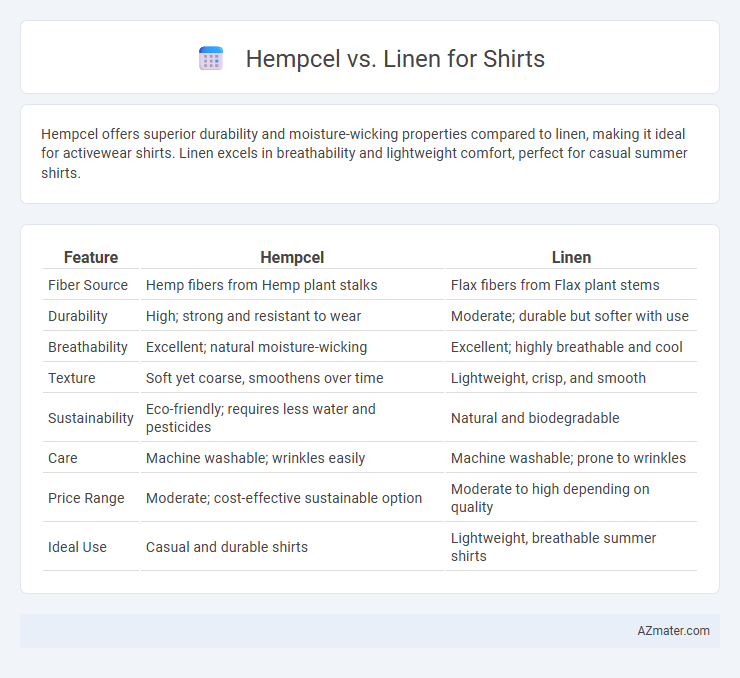Hempcel offers superior durability and moisture-wicking properties compared to linen, making it ideal for activewear shirts. Linen excels in breathability and lightweight comfort, perfect for casual summer shirts.
Table of Comparison
| Feature | Hempcel | Linen |
|---|---|---|
| Fiber Source | Hemp fibers from Hemp plant stalks | Flax fibers from Flax plant stems |
| Durability | High; strong and resistant to wear | Moderate; durable but softer with use |
| Breathability | Excellent; natural moisture-wicking | Excellent; highly breathable and cool |
| Texture | Soft yet coarse, smoothens over time | Lightweight, crisp, and smooth |
| Sustainability | Eco-friendly; requires less water and pesticides | Natural and biodegradable |
| Care | Machine washable; wrinkles easily | Machine washable; prone to wrinkles |
| Price Range | Moderate; cost-effective sustainable option | Moderate to high depending on quality |
| Ideal Use | Casual and durable shirts | Lightweight, breathable summer shirts |
Introduction to Hempcel and Linen Shirts
Hempcel shirts are crafted from hemp fibers, known for their durability, breathability, and natural antibacterial properties, making them ideal for eco-conscious consumers seeking sustainable fashion. Linen shirts, made from flax fibers, are celebrated for their lightweight texture, moisture-wicking abilities, and classic crisp appearance, perfect for warm-weather wear. Both fabrics offer distinct benefits, with hempcel providing enhanced strength and environmental sustainability, while linen excels in softness and traditional aesthetic appeal.
Fabric Composition and Sources
Hempcel fabric, derived from hemp fibers, boasts exceptional durability and breathability due to its natural cellulose content, making it a sustainable choice for shirts. Linen, sourced from flax plants, features a lightweight, moisture-wicking texture that excels in hot climates thanks to its strong lignin and cellulose fiber structure. Both fabrics emphasize eco-friendly cultivation practices, with hemp requiring less water and pesticides compared to flax, impacting their overall environmental footprint.
Sustainability and Environmental Impact
Hempcel fabric, derived from hemp fibers, boasts exceptional sustainability due to its low water usage, rapid growth cycle, and natural resistance to pests, significantly reducing the need for pesticides and fertilizers compared to linen made from flax. Linen production, while eco-friendly, typically requires more water and energy for processing, leading to a higher environmental footprint than hempcel. Hempcel's biodegradability and carbon sequestration properties position it as a superior choice for eco-conscious clothing, promoting sustainable fashion with minimal environmental impact.
Breathability and Comfort
Hempcel fabric offers superior breathability with its naturally porous fibers that wick moisture and allow air circulation, making it ideal for hot climates. Linen provides excellent comfort due to its lightweight, soft texture and quick-drying properties, which reduce sweat buildup and skin irritation. Both materials enhance shirt airflow, but Hempcel's durability combined with its breathability sets it apart for long-lasting comfort.
Durability and Longevity
Hempcel shirts outperform linen in durability due to hemp fibers being stronger and more resistant to wear and tear, making them ideal for long-term use. Hempcel's natural antifungal properties extend the longevity of shirts by reducing fiber degradation over time. Linen, while breathable and soft, tends to weaken and fray faster, especially with frequent washing and exposure to sunlight.
Moisture Absorption and Quick Drying
Hempcel fabric outperforms linen in moisture absorption due to its natural hemp fibers, which can absorb up to 20% more moisture than linen, making it ideal for high-humidity environments. The quick-drying properties of Hempcel are enhanced by its porous fiber structure that facilitates faster evaporation compared to linen's denser weave. This combination ensures Hempcel shirts remain dry and comfortable during extended wear, especially in hot or active conditions.
Style, Texture, and Aesthetic Appeal
Hempcel offers a natural, slightly rougher texture that softens with wear, lending shirts a rugged yet refined aesthetic perfect for casual, eco-conscious fashion. Linen provides a lightweight, crisp texture with a distinctive weave that delivers a classic, breathable shirt ideal for warm climates and elegant summer styles. Both fabrics enhance style with unique visual appeal--Hempcel emphasizes durability and earthiness, while linen showcases timeless sophistication and freshness.
Maintenance and Care Requirements
Hempcel shirts require minimal maintenance, benefiting from the natural antimicrobial and moisture-wicking properties of hemp, which reduce odor and the frequency of washes. Linen shirts, while breathable and lightweight, demand more careful handling to prevent wrinkles and may need ironing after washing to maintain their crisp appearance. Both fabrics are machine washable, but hempcel offers greater durability and faster drying times, making it a more practical option for low-maintenance shirt care.
Price Comparison and Availability
Hempcel shirts typically cost between $40 and $70, boasting sustainable hemp fabric that offers durability and moisture-wicking properties, but they may be less widely available due to limited production. Linen shirts generally range from $30 to $60 and are widely accessible in retail stores and online, favored for their breathability and classic texture. Availability of hempcel shirts remains more niche, while linen benefits from extensive supply chains and diverse style options.
Choosing the Best Fabric: Hempcel vs Linen
Hempcel offers superior durability and moisture-wicking properties compared to linen, making it ideal for activewear and extended wear. Linen excels in breathability and lightweight comfort, perfect for hot, humid climates and casual shirts. Choosing between Hempcel and linen depends on your priorities for fabric strength versus cooling performance.

Infographic: Hempcel vs Linen for Shirt
 azmater.com
azmater.com